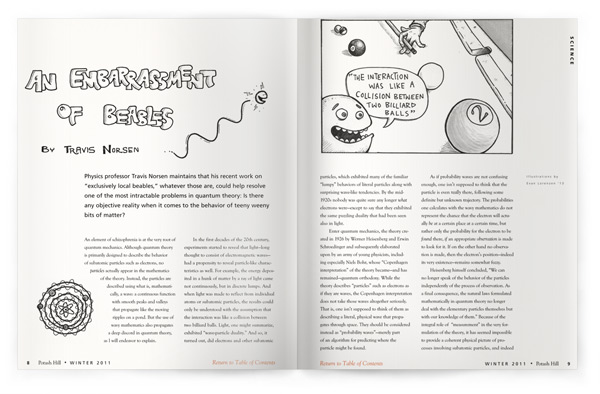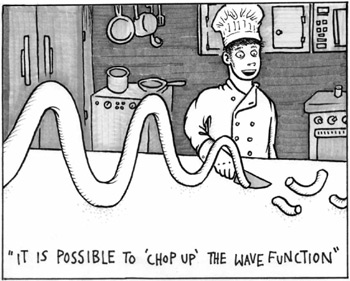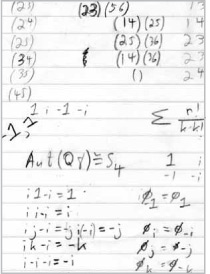An Embarrassment of Beables

Physics professor Travis Norsen maintains that his recent work on “exclusively local beables,” whatever those are, could help resolve one of the most intractable problems in quantum theory: Is there any objective reality when it comes to the behavior of teeny weeny bits of matter?
An element of schizophrenia is at the very root of quantum mechanics. Although quantum theory is primarily designed to describe the behavior of subatomic particles such as electrons, no particles actually appear in the mathematics of the theory. Instead, the particles are described using what is, mathematically, a wave: a continuous function with smooth peaks and valleys that propagate like the moving ripples on a pond. But the use of wavy mathematics also propagates a deep discord in quantum theory, as I will endeavor to explain.
In the first decades of the 20th century, experiments started to reveal that light—long thought to consist of electromagnetic waves—had a propensity to reveal particle-like characteristics as well. For example, the energy deposited in a hunk of matter by a ray of light came not continuously, but in discrete lumps. And when light was made to reflect from individual atoms or subatomic particles, the results could only be understood with the assumption that the interaction was like a collision between two billiard balls. Light, one might summarize, exhibited “wave-particle duality.” And so, it turned out, did electrons and other subatomic particles, which exhibited many of the familiar “lumpy” behaviors of literal particles along with surprising wave-like tendencies. By the mid-1920s nobody was quite sure any longer what electrons were—except to say that they exhibited the same puzzling duality that had been seen also in light.
Enter quantum mechanics, the theory created in 1926 by Werner Heisenberg and Erwin Schroedinger and subsequently elaborated upon by an army of young physicists, including especially Niels Bohr, whose “Copenhagen interpretation” of the theory became—and has remained—quantum orthodoxy. While the theory describes “particles” such as electrons as if they are waves, the Copenhagen interpretation does not take those waves altogether seriously. That is, one isn’t supposed to think of them as describing a literal, physical wave that propagates through space. They should be considered instead as “probability waves”—merely part of an algorithm for predicting where the particle might be found.
 As if probability waves are not confusing enough, one isn’t supposed to think that the particle is even really there, following some definite but unknown trajectory. The probabilities one calculates with the wavy mathematics do not represent the chance that the electron will actually be at a certain place at a certain time, but rather only the probability for the electron to be found there, if an appropriate observation is made to look for it. If on the other hand no observation is made, then the electron’s position—indeed its very existence—remains somewhat fuzzy.
As if probability waves are not confusing enough, one isn’t supposed to think that the particle is even really there, following some definite but unknown trajectory. The probabilities one calculates with the wavy mathematics do not represent the chance that the electron will actually be at a certain place at a certain time, but rather only the probability for the electron to be found there, if an appropriate observation is made to look for it. If on the other hand no observation is made, then the electron’s position—indeed its very existence—remains somewhat fuzzy.
Heisenberg himself concluded, “We can no longer speak of the behavior of the particles independently of the process of observation. As a final consequence, the natural laws formulated mathematically in quantum theory no longer deal with the elementary particles themselves but with our knowledge of them.” Because of the integral role of “measurement” in the very formulation of the theory, it has seemed impossible to provide a coherent physical picture of processes involving subatomic particles, and indeed questionable whether there is even any such realm of microscopic objective reality.
There exists an alternative theory of quantum phenomena, however, which has none of the measurement problems of the Copenhagen theory but makes precisely the same experimental predictions. Indeed, this alternative invites just the opposite kinds of philosophical extrapolations: Particles are really particles (whether anybody is looking at them or not), no special role is played by observation or measurement, and God (much to Einstein’s delight) does not play dice. The theory was first put forward by Louis de Broglie, also in 1926, but he was talked out of it by supporters of the Copenhagen view. It was independently rediscovered in 1952 by David Bohm and found its greatest champion in the physicist John Stewart Bell, starting in the 1960s.
Bell wrote: “Bohm’s 1952 papers on quantum mechanics were for me a revelation. [They eliminated] any need for a vague division of the world into ‘system’ on the one hand, and ‘apparatus’ or ‘observer’ on the other.” The need for such a “vague division” was, of course, just the point on which all orthodox quantum philosophy rested. But from Bell’s point of view, the contrast provided by the de Broglie-Bohm theory brought to light how unnecessary—indeed, how silly and unscientific—it was to posit a division between “measurement” and “non-measurement” as part of an allegedly fundamental physical theory.
 For example, consider how the orthodox theory treats a simple situation such as the infamous double-slit experiment: A particle is fired toward a screen with two parallel slits in it, behind which lies a detection screen such as the CCD array in your digital camera. The Copenhagen mathematics says that the particle propagates along as a wave, splitting in half and going through both of the two slits. But then the CCD array measures the particle itself, causing the wave to collapse, rather like a balloon pricked with a pin that suddenly deflates down to a single point. The very mathematical formulation of Copenhagen quantum mechanics involves a fundamental distinction between physical processes that are measurements and those that aren’t, producing the infamous quantum jumps.
For example, consider how the orthodox theory treats a simple situation such as the infamous double-slit experiment: A particle is fired toward a screen with two parallel slits in it, behind which lies a detection screen such as the CCD array in your digital camera. The Copenhagen mathematics says that the particle propagates along as a wave, splitting in half and going through both of the two slits. But then the CCD array measures the particle itself, causing the wave to collapse, rather like a balloon pricked with a pin that suddenly deflates down to a single point. The very mathematical formulation of Copenhagen quantum mechanics involves a fundamental distinction between physical processes that are measurements and those that aren’t, producing the infamous quantum jumps.
Bell’s point, in effect, was this: What the heck is a “measurement?” This just isn’t the kind of concept one expects to show up in the fundamental laws of microphysics, because it is anthropocentric: “Making measurements” is something people do, not something electrons or the laws governing their behavior ought to know or care about. Bell asked, with tongue in the vicinity of cheek: “What exactly qualifies some physical systems to play the role of ‘measurer’? Was the wave function of the world waiting to jump for thousands of millions of years until a single-celled living creature appeared? Or did it have to wait a little longer, for some better qualified system . . . with a Ph.D.?”
If one can have quantum physics (including its amazing predictive and indeed practical powers) without the fuzzy quantum philosophy, why haven’t more physicists adopted the alternative viewpoint? One possible source of discomfort is known as a “beable” (a term Bell coined that rhymes with “agreeable,” not “feeble”), which brings us finally to some recent work I’ve done. In deliberate contrast to the “observables,” which play an absurdly central role in the formalism of standard quantum mechanics, beables are all those elements in a theory that are supposed to be taken seriously—as corresponding to things that really exist physically, whether anyone is observing them or not.
Bell argued that in the Copenhagen quantum theory, it’s just not clear what the beables are, i.e., which elements in the theory (if any) are supposed to correspond to physically real things. The wave function, for example, is kept in deliberate limbo between the physical and the mental: It’s a mere “probability wave” (whatever that means). In the de Broglie-Bohm theory, by contrast, the ontological status of things is clear: The beables of the theory include both the particles and the guiding wave field. Both of these can and indeed must be thought of as referring to physical objects that exist and interact in the same way all the time, regardless of whether any observations or measurements are happening. It’s just an ordinary physics theory of the sort that any sensible person would have expected prior to being exposed to the Copenhagen philosophy.
But still there’s a puzzle. The particles in the de Broglie-Bohm theory are what Bell called “local beables.” This means that they exist and move around in ordinary, three-dimensional physical space. But the wave field that guides them—that is, the usual quantum mechanical wave function obeying Schroedinger’s equation—is by contrast a “non-local beable.” This means it exists not in ordinary, three-dimensional physical space, but . . . somewhere else. Mathematically, the wave is a function not just of the three spatial dimensions (x, y and z, say) but rather of the coordinates of all the particles simultaneously: The x coordinate of particle 1, the y coordinate of particle 1, the z coordinate of particle 1, the x coordinate of particle 2, and so on. For a Bohmian universe containing N particles, then, the wave function exists in a space of not three but 3N dimensions.
The “out of this world” character of the wave function has been an embarrassment for people wanting to take the wave function as a beable since the very beginning of quantum mechanics. For example, in the months after Schroedinger first proposed his eponymous equation in 1926, Einstein was contemplating the possibility that the role of the wave function might be to steer individual particles, as in the mature de Broglie-Bohm theory. He rejected this possibility, however, on the grounds that one simply couldn’t take seriously the idea of a physically real wave living in this abstract, high-dimensional space: “Schroedinger is, in the beginning, very captivating. But the waves in n-dimensional coordinate space are indigestible . . . ”
 Later, in the 1960s, after Bohm had rediscovered and developed the pilot-wave picture and was lobbying for it as an alternative to the Copenhagen theory, Heisenberg criticized it on these same grounds. And this, more or less, is how things have stood since. Most physicists have remained simply unaware of the existence of the de Broglie-Bohm alternative to Copenhagen quantum physics, and most of those who are aware of it have dismissed it on erroneous grounds—that it conflicts with relativity theory (actually a problem with all current theories of quantum mechanics). A very small minority of physicists, however, has perceived the theory’s great virtues and has thus developed and championed it, learning to live, as it were, with the embarrassment of needing to accept the wave function as a non-local beable.
Later, in the 1960s, after Bohm had rediscovered and developed the pilot-wave picture and was lobbying for it as an alternative to the Copenhagen theory, Heisenberg criticized it on these same grounds. And this, more or less, is how things have stood since. Most physicists have remained simply unaware of the existence of the de Broglie-Bohm alternative to Copenhagen quantum physics, and most of those who are aware of it have dismissed it on erroneous grounds—that it conflicts with relativity theory (actually a problem with all current theories of quantum mechanics). A very small minority of physicists, however, has perceived the theory’s great virtues and has thus developed and championed it, learning to live, as it were, with the embarrassment of needing to accept the wave function as a non-local beable.
Not one to tolerate embarrassment, I began to meditate on this problem some years ago, and eventually made a small but perhaps important breakthrough. By means of what can only be described as a mathematical trick (which, for students who have taken calculus, amounts to the use of Taylor expansions), it is possible to “chop up” the wave function (on the 3N-dimensional space) into a number of distinct functions that live in ordinary three-dimensional space. That is, it is possible to mathematically rewrite the de Broglie-Bohm theory with a number of local beables—namely, waves propagating in physical space—in place of the non-local beable of the traditional formulation.
That was the good news. The bad news was that the number of distinct wave fields that resulted from the “chopping up” operation was itself rather embarrassing: An infinite number of such fields are required to achieve mathematical equivalence with the usual formulation. And there are other embarrassments as well: The particular mathematical “chopping up” operation I used will only work if one ignores a property called “spin” that particles are known to possess. There areseveral other features that only add to the feeling that the proposal is impossible to take too seriously as a candidate theory. But hey, Rome wasn’t built in a day.
 Despite its many problems, the new perspective on the de Broglie-Bohm theory makes what I think is a crucial point of principle: The Schroedinger wave function can (to use Einstein’s phrase) “be transplanted from the n-dimensional coordinate space to the three . . . dimensional.” It’s not impossible. My goal in pursuing and reporting on this research has been an admittedly unserious and tentative proof that the kind of theory sought after by Einstein—a “theory of exclusively local beables”—is maybe not as out of reach as people seem to have assumed. My intention is to reignite this long-forgotten but prematurely abandoned research program. Only time will tell where it might lead, but the hope is that with a little work—almost certainly by people smarter than I—a really plausible, nice-looking theory of exclusively local beables could be constructed. This would go a long way toward making quantum theory more “digestible.”
Despite its many problems, the new perspective on the de Broglie-Bohm theory makes what I think is a crucial point of principle: The Schroedinger wave function can (to use Einstein’s phrase) “be transplanted from the n-dimensional coordinate space to the three . . . dimensional.” It’s not impossible. My goal in pursuing and reporting on this research has been an admittedly unserious and tentative proof that the kind of theory sought after by Einstein—a “theory of exclusively local beables”—is maybe not as out of reach as people seem to have assumed. My intention is to reignite this long-forgotten but prematurely abandoned research program. Only time will tell where it might lead, but the hope is that with a little work—almost certainly by people smarter than I—a really plausible, nice-looking theory of exclusively local beables could be constructed. This would go a long way toward making quantum theory more “digestible.”
Travis Norsen teaches physics and astronomy at Marlboro, and recently authored a textbook tracing the history, development and applications of Newton’s theory of universal gravitation and the atomic theory of matter. To learn more about Travis’ work on exclusively local beables, click the links on his faculty profile at www.marlboro.edu/academics/faculty/norsen_travis/
Unintuitive but elegant math
 If you can imagine wave functions in an n-dimensional space, you may also be ready for a field of mathematics called group theory, the Plan subject of Devin Wilmott ’11. “The ideas behind group theory are fairly unlike any other discipline I have seen, and lead to surprising and unintuitive but elegant results,” said Devin. Group theory requires a leap of imagination to leave behind most of the mathematical rules, or axioms, we know and love (such as x + y = y + x); then collections of objects, or “groups,” are found to interact with each other in new and significant ways. “Groups derive their power from their lack of constraints,” said Devin. “They can represent a number of things that make less sense in other contexts.” Group theory has many applications, including algebraic topology, cryptography, musical set theory, physics and chemistry.
If you can imagine wave functions in an n-dimensional space, you may also be ready for a field of mathematics called group theory, the Plan subject of Devin Wilmott ’11. “The ideas behind group theory are fairly unlike any other discipline I have seen, and lead to surprising and unintuitive but elegant results,” said Devin. Group theory requires a leap of imagination to leave behind most of the mathematical rules, or axioms, we know and love (such as x + y = y + x); then collections of objects, or “groups,” are found to interact with each other in new and significant ways. “Groups derive their power from their lack of constraints,” said Devin. “They can represent a number of things that make less sense in other contexts.” Group theory has many applications, including algebraic topology, cryptography, musical set theory, physics and chemistry.